As Putin Hosts Grand Victory Day Parade with Xi Jinping and Other Foreign Leaders, Russian Forces Violate Self-Declared Ceasefire; European Ministers Approve Special Tribunal for Russian Leadership While Trump Calls for 30-Day Truce
Summary of the Day – May 9, 2025
As Vladimir Putin orchestrated a carefully staged Victory Day pageant in Moscow showcasing Russian military might and international alliances, the reality on the battlefield told a starkly different story. Russia’s self-declared three-day “humanitarian pause” was violated within hours as guided aerial bombs rained down on Sumy Oblast and attacks killed civilians in multiple regions. Meanwhile, a significant diplomatic counterpoint unfolded in Lviv, where delegations from 35 countries formalized plans for a special tribunal to prosecute Russia’s leadership for the crime of aggression. In Washington, President Trump called for a 30-day unconditional ceasefire as European leaders prepared to visit Kyiv in a show of solidarity, significantly narrowing the diplomatic daylight between Ukraine and its Western backers amid increasing pressure on Moscow to accept meaningful peace talks.
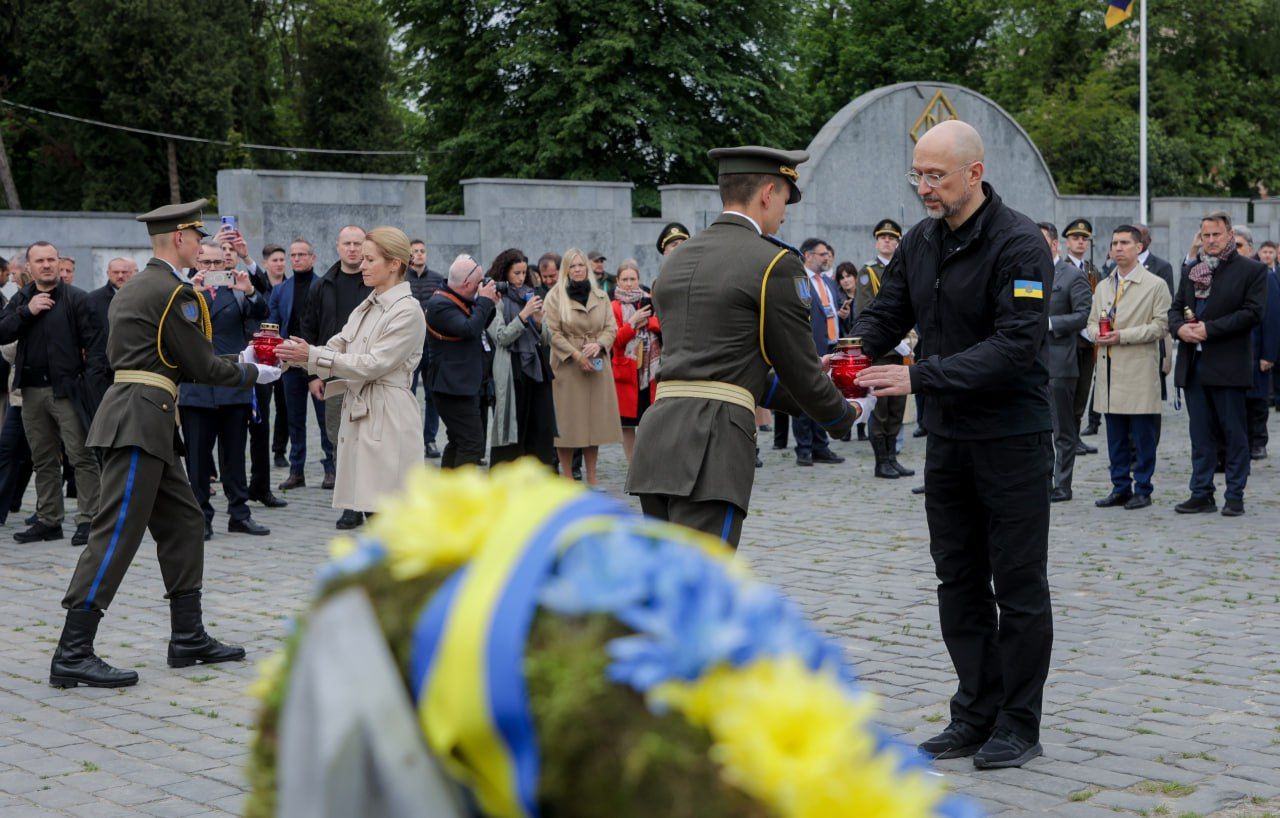
EU foreign ministers and foreign policy chief Kaja Kallas honored fallen Ukrainian soldiers in Lviv. (Prime Minister Denys Shmyhal / Telegram)
Phantom Peace: Russia’s Ceasefire Claims Shattered by Continued Attacks
Russia’s self-declared Victory Day truce, announced by the Kremlin to run from May 8 to midnight on May 11, proved little more than a theatrical gesture aimed at providing favorable optics for Moscow’s Victory Day celebrations. Within hours of the supposed humanitarian pause, Ukrainian authorities reported Russian forces had launched 130 guided aerial bombs against Sumy Oblast on May 8, followed by an additional 56 bombs by midday on May 9.
The deadly charade continued as Russian attacks killed at least two civilians and wounded 12 others across Ukraine during the supposed ceasefire. In Kharkiv Oblast, five people were injured by FPV drone and artillery attacks. Russian strikes in Kherson Oblast killed one person and wounded another while damaging residential buildings. In Zaporizhzhia Oblast, a woman was killed in another Russian attack, while two others were injured by an FPV drone strike. Donetsk Oblast saw three residents wounded, and an 83-year-old man was injured in Dnipropetrovsk Oblast.
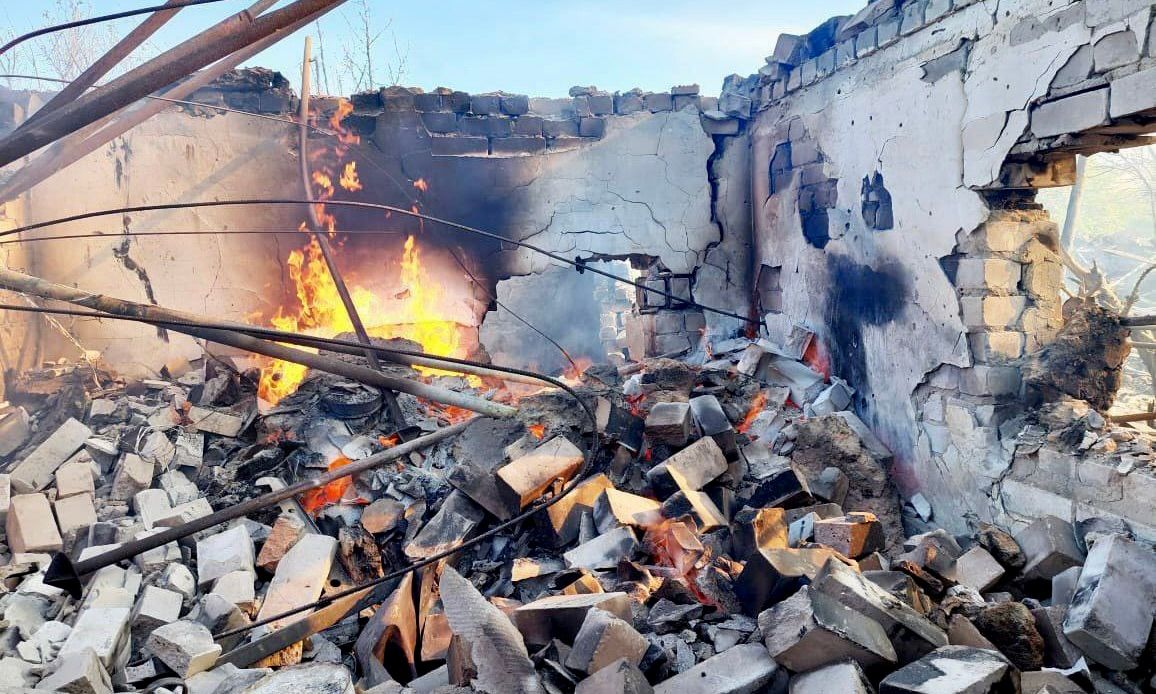
Damage following a Russian attack on Ukraine’s Zaporizhzhia Oblast. (Ivan Fedorov / Telegram)
In a particularly brazen attack, a Ukrainian drone struck the government building of Russia’s Belgorod Oblast on the morning of May 9, injuring deputy governor Alexandr Lorenz, according to regional governor Vyacheslav Gladkov. The attack was carried out by an aircraft-type drone, with footage of the aftermath shared on Telegram. A Russian Guard officer also suffered a shrapnel wound to the thigh and was hospitalized. This incident occurred as Russia was celebrating its Victory Day, highlighting the tense security situation even in Russian territory.
US Embassy Warning: Security Alert Issued as Attacks Continue
The U.S. Embassy in Kyiv heightened alarm by issuing a serious warning on May 9 about “a potentially significant air attack that may occur at any time over the next several days,” advising U.S. citizens to be prepared to seek shelter immediately if air raid sirens sound. “The Embassy, as always, recommends U.S. citizens be prepared to immediately shelter in the event an air alert is announced,” the statement read, reflecting growing concerns about Russian escalation despite the declared ceasefire.
The warning came as Ukraine’s Air Force spokesperson Yuriy Ihnat confirmed Russian forces were continuing to deploy guided aerial bombs, with nearly 10 Russian aircraft operating near the front line’s Donetsk, Zaporizhzhia, and Sumy sectors even as Moscow celebrated its military victory over Nazi Germany. With air defense systems stretched thin across Ukraine, the alert underscored the persistent threats facing both Ukrainian citizens and foreign nationals in the country.
Moscow’s Propaganda Parade: Xi, North Korean Troops, and Seagal Attend Victory Day Celebration
Putin’s Red Square spectacle featured traditional military pomp but with notable additions designed to project an image of international support in the face of Western isolation. The parade’s foreign attendance list became a visual referendum on Russia’s global standing, with Chinese President Xi Jinping seated prominently beside Putin, while North Korean troops who had fought for Russia in Ukraine marched alongside Russian forces.
More than 11,500 troops participated, including 1,500 who had fought in Ukraine. Military hardware displays included Iskander ballistic missiles, attack drones, and even the nuclear-capable Yars intercontinental ballistic missile—a dramatic increase from the scaled-down 2023 and 2024 parades.
Putin’s carefully curated guest list included Brazilian leader Luiz Inacio Lula da Silva and the heads of Cuba, Belarus, Venezuela, Vietnam, Ethiopia, and Egypt. Former Hollywood actor Steven Seagal, who became a Russian citizen in 2016, attended seated near the “Night Wolves,” a pro-Kremlin motorcycle gang known for aiding Moscow’s 2014 annexation of Crimea. Perhaps most controversially, Slovak Prime Minister Robert Fico defied EU warnings to become the sole EU nation head present, forced to reroute his flight when Lithuania denied his aircraft entry into its airspace.
In his speech, Putin framed Russia as “an indestructible barrier to Nazism” while claiming “the whole country, society, and people support the special military operation” in Ukraine. He deliberately conflated Russian and Soviet soldiers in his historical narrative, a distortion aimed at claiming sole Russian ownership of the Soviet victory in World War II—despite the fact that six million Ukrainians fought in the Soviet army, with an estimated 1.65 million killed.
European Counter-Move: Special Tribunal Approved for Russian Leadership
On the same day Russia showcased its military pageantry, EU foreign ministers gathered in Lviv to approve the creation of a special tribunal to prosecute Russia’s top leadership for “the crime of aggression against Ukraine,” a deliberate counterpoint to Moscow’s propaganda effort.
The tribunal, which will operate under the Council of Europe, aims to hold President Vladimir Putin and approximately 20-30 top Russian officials responsible for launching the invasion. This fills a crucial gap in international justice, as the International Criminal Court (ICC) in The Hague, which has already issued arrest warrants for Putin over the abduction of Ukrainian children, lacks jurisdiction to prosecute Russia for the fundamental decision to invade.
“It is important and symbolic that European partners stand side by side with Ukraine on Europe Day,” Ukrainian Prime Minister Denys Shmyhal wrote. The next formal step will come at the Council of Europe’s Committee of Ministers meeting in Luxembourg on May 13-14.
This expedited timeline follows concerns that U.S. President Donald Trump’s peace efforts could ultimately allow Russia’s leadership to escape justice. While Putin cannot be tried while in office due to sovereign immunity principles, prosecutors could prepare charges to be activated when he leaves power, while other Russian officials without immunity could face trial immediately.
Trump’s Peace Push: Calls for 30-Day Unconditional Ceasefire
U.S. President Donald Trump publicly called for “a 30-day unconditional ceasefire” between Ukraine and Russia, significantly aligning Washington’s position with Ukraine’s longstanding willingness to accept a complete cessation of hostilities. Trump’s statement explicitly endorsed Ukraine’s sequencing preference—a ceasefire first, followed by peace negotiations—which Russia has consistently rejected.
“This ceasefire must ultimately build toward a peace agreement,” Trump stated, adding he is committed to securing a Ukrainian-Russian peace with European involvement. Vice President JD Vance noted that Russia is demanding “too much” because it perceives battlefield momentum, specifically criticizing Putin’s demand that Ukraine cede territory Russian forces do not currently occupy.
According to Reuters, American and European officials are in the final stages of working on a ceasefire proposal, with additional sanctions being considered if Russia refuses to observe the truce. Ukrainian President Volodymyr Zelensky confirmed after his May 8 phone call with Trump that the United States, Ukraine, and Europe are “on the same page” about the necessity of a full ceasefire.
European Leaders Unite: Four Nations to Visit Kyiv in Show of Support
In a powerful demonstration of European solidarity with Ukraine, the leaders of four influential European nations announced they would visit Kyiv on May 10—the day after Russia’s Victory Day celebrations. UK Prime Minister Keir Starmer, French President Emmanuel Macron, German Chancellor Friedrich Merz, and Polish Prime Minister Donald Tusk planned to meet with President Zelensky in what marks the first time leaders of all four countries would travel to Ukraine together.
The timing of the visit—coming immediately after Putin’s Victory Day parade—was deliberate, designed to counter Russia’s propaganda showcasing international support. For Merz, recently sworn in as Germany’s chancellor on May 6, this will mark his first visit to Ukraine in his new role.
The joint statement from the four leaders explicitly endorsed Trump’s ceasefire proposal: “We reiterate our backing for President Trump’s calls for a peace deal and call on Russia to stop obstructing efforts to secure an enduring peace. Alongside the U.S., we call on Russia to agree to a full and unconditional 30-day ceasefire to create the space for talks on a just and lasting peace.”
They also announced plans to brief allies on the formation of a future coalition to monitor peace in Ukraine. This “air, land, maritime, and regeneration force” would help bolster Ukraine’s military following an eventual peace deal and “strengthen confidence in any future peace.”
German Chancellor Expresses Optimism: Ceasefire Could Be Reached “This Weekend”
Newly sworn-in German Chancellor Friedrich Merz expressed unexpected optimism about the prospects for a ceasefire, telling reporters in Brussels on May 9 that an agreement between Russia and Ukraine could be reached as early as this weekend.
“I have great hope that an agreement for a ceasefire in Ukraine will be reached this weekend,” Merz said, according to the German outlet Die Welt. The chancellor, who took office just three days earlier on May 6, suggested there is a “great chance” that Russia’s three-day truce could be extended to 30 days, potentially opening the door for peace negotiations.
Merz’s comments came shortly before his planned first visit to Ukraine as chancellor, where he will join French President Emmanuel Macron, UK Prime Minister Keir Starmer, and Polish Prime Minister Donald Tusk in Kyiv on May 10. According to the chancellor, the European leaders’ ceasefire proposal is “largely identical” to the American version.
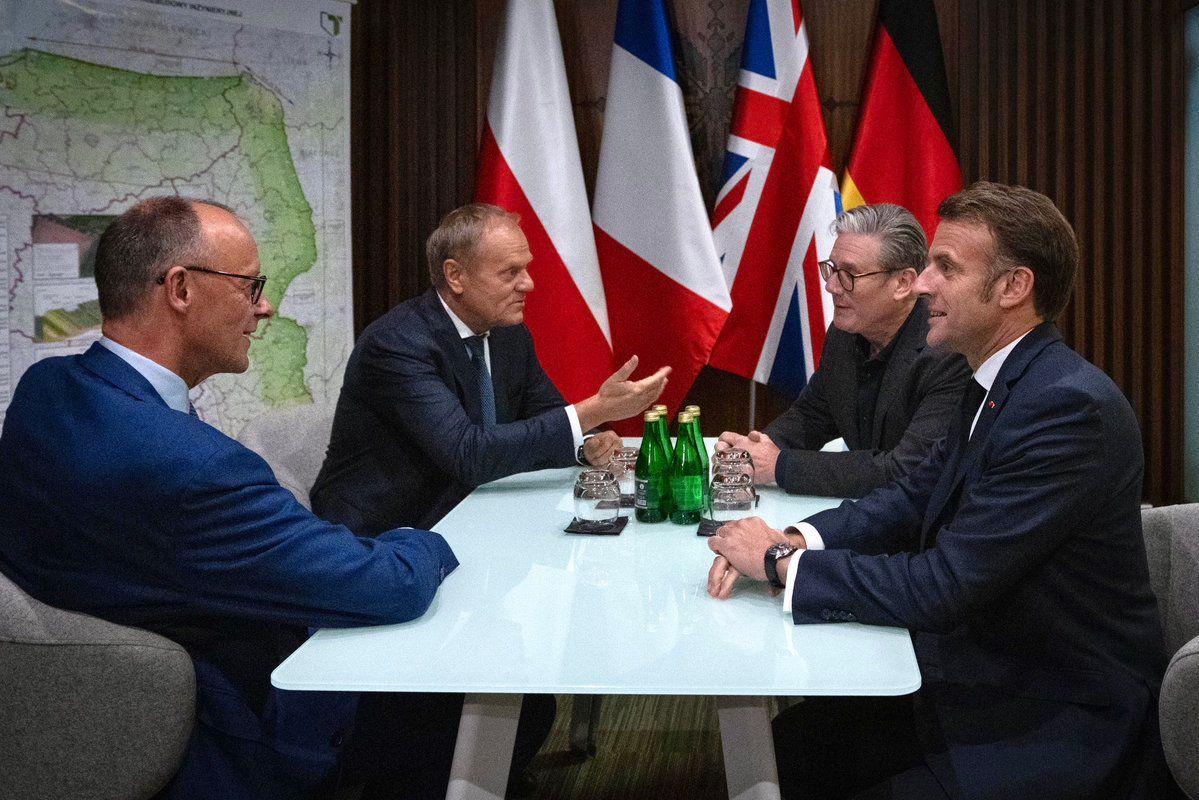
German Chancellor Friedrich Merz, Polish Prime Minister Donald Tusk, U.K. Prime Minister Keir Starmer, and French President Emmanuel Macron en route to Kyiv. (Emmanuel Macron / X)
“We very much hope that this will also be accepted on the Russian side,” Merz added, concluding that “the ball is entirely in Moscow’s court.” His optimistic assessment represents the most concrete timeline yet offered by a major Western leader regarding the potential for a breakthrough in the stalled peace process.
EU Military Support Expands: €1.9 Billion From Russian Assets Allocated
Ukraine secured a significant financial commitment from its European allies during the Lviv meeting, with the EU pledging to supply over 1.35 million artillery rounds in 2025 and allocating nearly €1.9 billion ($2.1 billion) from frozen Russian assets for military support.
“This is a historic decision, as weapons for Ukraine will be purchased at the expense of the proceeds from frozen Russian assets through the European Peace Fund,” Prime Minister Denys Shmyhal announced. One billion euros ($1.1 billion) of this sum will be used to purchase weapons directly from Ukrainian manufacturers, following the Danish model of procurement. Another 600 million euros ($676 million) will go toward artillery and ammunition, while more than 200 million euros ($226 million) will strengthen Ukraine’s air defense capabilities.
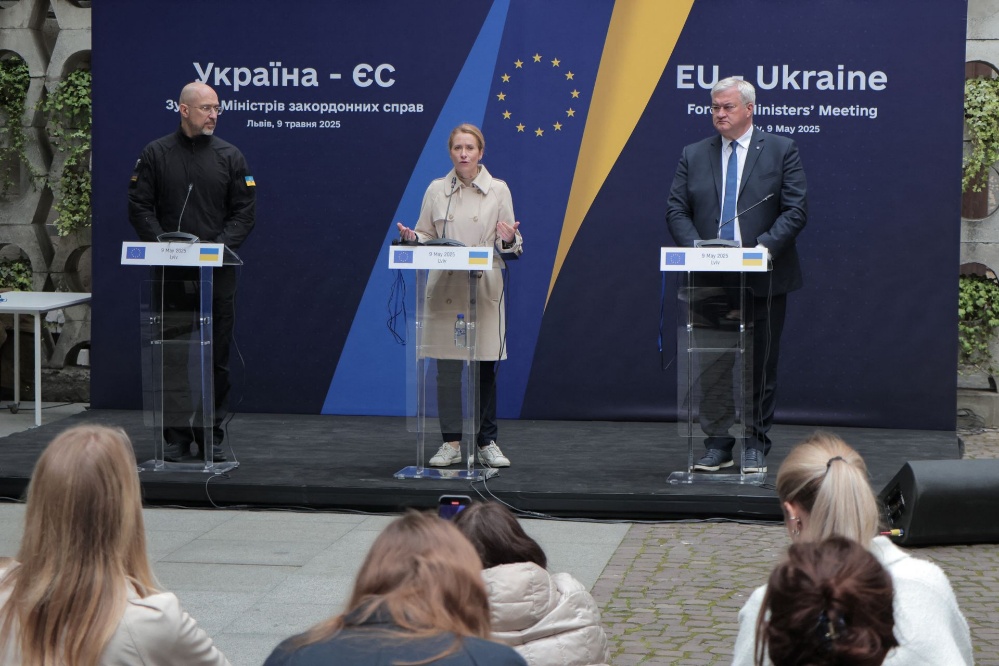
Ukrainian Prime Minister Denys Shmyhal (L), Ukrainian Minister of Foreign Affairs Andrii Sybiha (R), and EU foreign policy chief Kaja Kallas speak during a Ukraine-EU meeting in Lviv (Sergii Volskyi / AFP via Getty Images)
French Foreign Minister Jean-Noël Barrot announced that Paris will allocate profits from frozen Russian assets specifically for the maintenance of CAESAR 155mm howitzers, of which Ukraine has received dozens since 2022. According to the April 15 report by the Kiel Institute for the World Economy’s Ukraine Aid Tracker, Europe has allocated €138 billion ($157 billion) in total aid since the beginning of the full-scale invasion, outpacing U.S. assistance by €23 billion ($26 billion).
Enhanced Alliances: France and Poland Sign Historic Defense Treaty
France and Poland significantly strengthened their bilateral defense ties on May 9, signing a treaty that commits both sides to mutual assistance in case of an attack by an aggressor. French President Emmanuel Macron and Polish Prime Minister Donald Tusk formalized the agreement in France’s eastern city of Nancy, with both leaders among the strongest European backers of Ukraine.
“In the event of armed aggression on their territories, the parties shall provide mutual assistance, including by military means,” states the text of the friendship and cooperation treaty. Macron emphasized that a key aspect of the treaty was the “mutual defense” clause, which adds to the protections already offered by NATO and the European Union rather than replacing them.
The French president, who leads the EU’s only nuclear weapons power, implied that France’s atomic arsenal could be part of such assistance. “The interests of our main partners are integrated in deciding what our vital interests are,” he said—a statement of immense interest to Poland, which shares a border with Russia’s Kaliningrad exclave and has repeatedly warned it could be targeted by Russian aggression.
Commenting on Putin’s Victory Day statements, Macron painted a bleak picture of the Russian leader’s interest in peace: “President Putin is on the side of war, not the side of peace. The belligerent comments that he made, the reality of every day, only underline that.”
UK Sanctions Russian ‘Shadow Fleet’: Largest Ever Financial Package Targets Oil Tankers
The United Kingdom announced its “largest ever” sanctions package against Russia’s “shadow fleet” on May 9, imposing restrictions on 100 oil tankers and an additional vessel said to be supporting the Russian government.
London’s latest round of sanctions name 100 shadow fleet tankers that have shipped over $24 billion in cargo since 2024, according to a press release. The penalties also target another ship “involved in obtaining a benefit from or supporting” the Kremlin, as well as several individuals and entities in the Russian energy and financial services sectors.
“The threat from Russia to our national security cannot be underestimated, that is why we will do everything in our power to destroy his shadow fleet operation, starve his war machine of oil revenues, and protect the subsea infrastructure that we rely on for our everyday lives,” UK Prime Minister Keir Starmer said.
The latest sanctions package means that the UK has imposed penalties on more shadow fleet vessels than any other country. Moscow’s shadow fleet consists of aging tankers used to circumvent sanctions imposed by the UK, EU, and U.S. These vessels often operate under obscure ownership structures, use flags of convenience, and evade Western oversight.
Ukrainian Sanctions Package: Targeting Russian and International Entities
President Volodymyr Zelensky imposed a new round of sanctions on May 9, targeting Russian nationals and companies from Russia, China, Iran, and Uzbekistan, according to a decision of Ukraine’s National Security and Defense Council. The comprehensive sanctions list includes 58 individuals and 74 companies, with 67 Russian enterprises specifically related to military technology. The decree came into force immediately upon publication.
Among the sanctioned individuals are artists and business owners, including Vadim Tsyganov, a poet, artist, and producer of Russian singer Victoria Tsyganova, who have actively supported Russia’s invasion of Ukraine. Also targeted are Yuriy Churkin, CEO of the Fort machine tool plant, and Petro Vashchenko, head of the company Unimatic—plants that supply advanced technologies used in the war effort against Ukraine.
The sanctions against companies affect several Russian enterprises, including the Novolipetsk Steel Plant, Novatek, Arctic LNG, Stoilensky Mining and Processing Plant, Volzhsky Abrasive Works, and Magnitogorsk Electrode Plant. This represents Ukraine’s continued efforts to use economic pressure against those supporting Russia’s military-industrial complex.
Military Realignments: Russia Uses Victory Day to Showcase Adaptations
Russian officials deliberately highlighted technological adaptations and innovations that Russian forces have integrated in Ukraine over the last three years during national and regional Victory Day celebrations—an attempt to frame these battlefield improvisations as evidence of military advancement rather than desperation.
Russian state media showed Russian forces displaying Orlan-10, Orlan-30, and Zala reconnaissance drones; Lancet-51 and Lancer-52 loitering munitions; and Geran and Garpiya long-range strike drones during the Victory Day parade in Moscow. RIA Novosti posted footage of Russian forces riding in Chinese-made all-terrain vehicles (ATVs) and Russian-made buggies during a Victory Day parade in Khabarovsk City, while other Russian media showed tanks equipped with counter-drone netting at a parade in Yekaterinburg.
These displays—featuring Russia’s increased use of counter-drone netting, ATVs, buggies, and motorcycles—highlighted tactical adaptations made in response to Ukrainian drone operations. The prominence given to these innovations during Victory Day suggests the Russian military intends to preserve these adaptations in future military operations rather than reverting to pre-2022 forms of combat.
Battlefield Developments: Recent Advances by Both Sides
Amid the diplomatic exchanges and Victory Day activities, significant military developments continued across multiple sectors of the front. According to geolocated footage published on May 9, Ukrainian forces recently advanced in southwestern Tetkino in Russia’s Kursk Oblast. The Ukrainian General Staff implied that Russian forces violated Russia’s ceasefire and attacked in undefined areas of Kursk Oblast on May 8 and 9, while Russian milbloggers claimed that Ukrainian forces had attacked near Tetkino and Novyi Put.
On the Russian side, geolocated footage published on May 9 confirmed Russian advances in central Kotlyarivka (northeast of Novopavlivka) and along Likarniana Street in central Bahatyr (west of Kurakhove). Russian troops have also recently advanced into central Zvirove (southwest of Pokrovsk), according to visual evidence.
Meanwhile, Japanese OSINT analysts revealed Russian decoy S-300 and S-400 air defense systems deployed in Russia’s Far East. Ukrainian Center for Countering Disinformation Head Lieutenant Andriy Kovalenko shared this imagery, noting that Russia had moved an unspecified number of these air defense assets to western Russia, including to Ust-Luga in Leningrad Oblast, Engels Air Base in Saratov Oblast, Savasleyka Air Base in Nizhny Novgorod Oblast, and Moscow Oblast—apparently to reinforce protection of these strategic locations.
Ukrainian Resistance: Yellow Ribbon Movement Defies Russian Victory Day Propaganda
As Moscow celebrated Victory Day with grand military parades, Ukrainians living under Russian occupation maintained their resistance through small but significant acts of defiance. Members of the Yellow Ribbon civil resistance movement—operating in occupied Crimea and parts of Luhansk, Donetsk, Zaporizhzhia, and Kherson oblasts—deliberately avoided participation in Russian-organized events.
“When my child hears about May 9 they almost scream, and so do I,” an activist living in the Russian-occupied town of Tokmak in Zaporizhzhia Oblast told Ukrainian media. “We have learnt all the songs, the Soviet uniform is already lying at home because we were forced to buy it, and every third homework assignment for six months has been about it.”
Another activist in Melitopol described their resistance: “We don’t want to celebrate at all—the occupiers have distorted the very essence of this day. But for ourselves, we remember the dead, because this is a day of remembrance, not celebration.”
The resistance continues despite grave risks—anyone defying occupation authorities faces imprisonment and torture. Russian authorities have attempted to enforce participation in Victory Day events, with schools in occupied territories making parade viewing compulsory for students and staff. In Sevastopol, Crimea, schoolchildren were forced to draw postcards for the Russian military, though some parents withdrew their children from school rather than comply.
Stalin Monument Unveiled in Occupied Melitopol: Russian Occupation Enforces Soviet Nostalgia
In a disturbing symbol of Russia’s ongoing efforts to rewrite history in occupied territories, the Communist Party of Russia unveiled a monument to Soviet dictator Joseph Stalin in occupied Melitopol, Zaporizhzhia Oblast, on May 9 to commemorate Victory Day. The statue carries a provocative plaque reading: “To the organizer and inspirer of the victory of the Soviet people over the Nazi invaders, Generalissimo of the Soviet Union Joseph Stalin, from grateful descendants.”
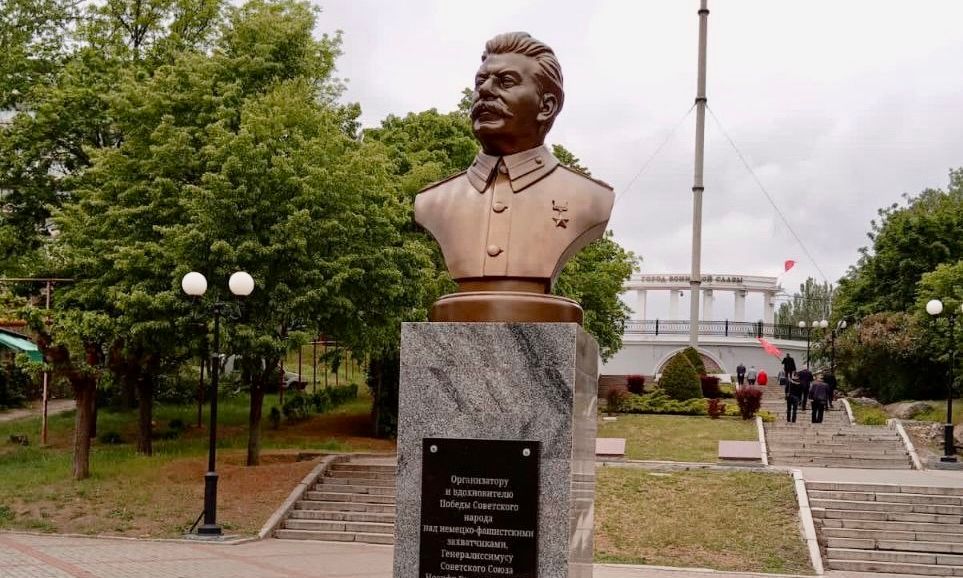
The Communist Party of Russia unveiled a monument to Soviet dictator Joseph Stalin in occupied Melitopol, Zaporizhzhia Oblast. (SOTA / Telegram)
The ceremony was attended by Russian-installed officials and local schoolchildren who were compelled to lay flowers at the site. This glorification of Stalin—whose regime caused the deaths of millions of Ukrainians during the Holodomor famine of 1932-1933—represents a particularly egregious example of Russia’s attempts to impose Soviet historical narratives in occupied Ukrainian territories.
The monument’s unveiling comes amid a broader revival of Stalin’s cult in Russia itself. On April 29, Russian President Vladimir Putin signed a decree renaming Volgograd’s international airport to “Stalingrad,” days after Russian media reported that Putin had endorsed the renaming of Volgograd’s Gumrak airport to honor the dictator, demonstrating Moscow’s continued rehabilitation of the Soviet tyrant as part of its nationalist ideology.
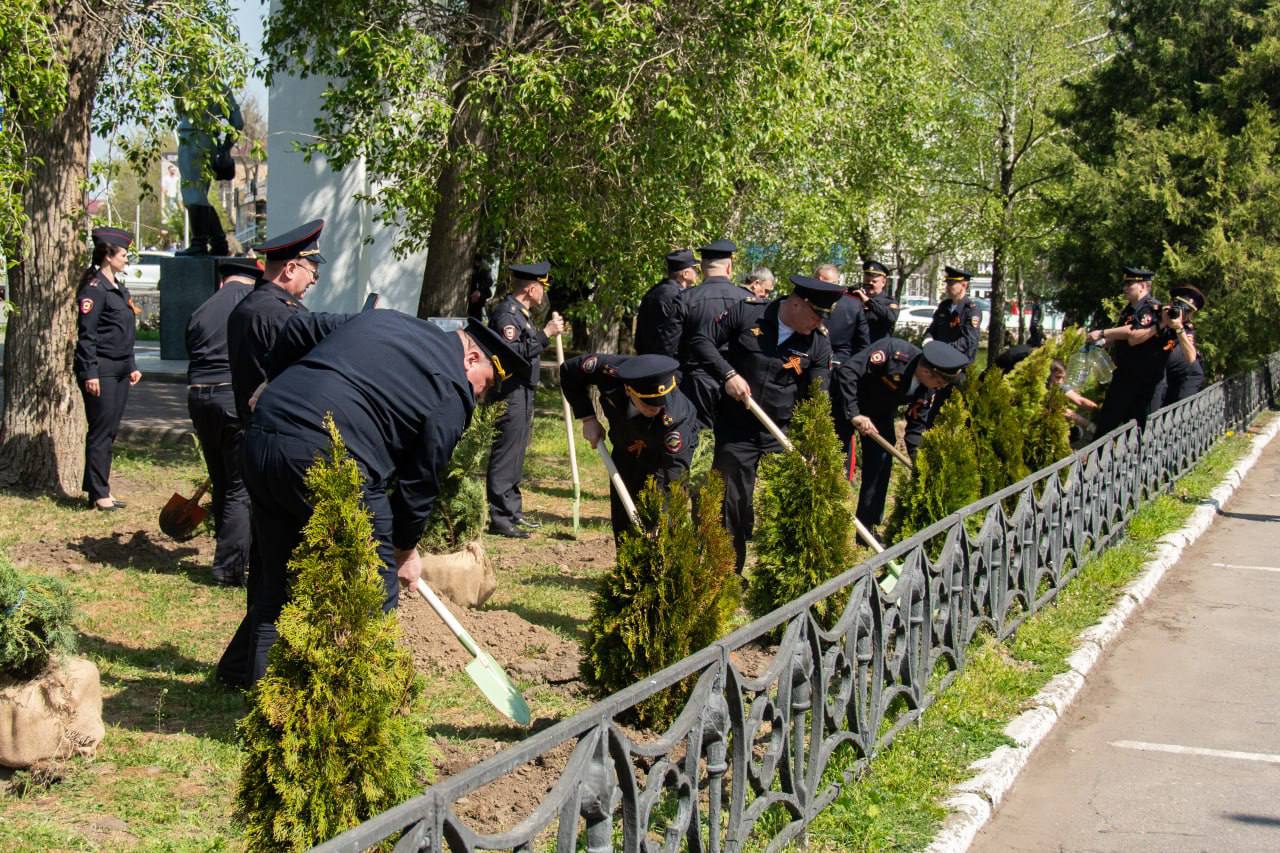
People participate in an event organized by Russian occupation authorities in Melitopol, Ukraine, in a photo published by pro-Kremlin media. (Telegram)
China-Russia Partnership: Xi Jinping and Putin Strengthen Strategic Ties
Chinese President Xi Jinping and Russian President Vladimir Putin reaffirmed their nations’ strategic partnership during a tea meeting in Moscow on May 9, following their more formal discussions the previous day. According to China’s Foreign Ministry readout, Xi emphasized that China and Russia will continue to cooperate closely despite international pressures, saying no external force could block their development or their long-term friendship.
On the war against Ukraine, Xi reiterated China’s support for a diplomatic solution through dialogue and negotiations while stressing that global security must address the “legitimate concerns of all countries” and tackle what he described as the “root causes” of crises. This language notably mirrored Putin’s own talking points about the conflict.
Both leaders criticized Western influence in global affairs and called for a more multipolar world order. Their May 8 joint statement referenced Putin’s original war aims in Ukraine and called for the resolution of the war to eliminate the “root causes”—widely interpreted as a tacit endorsement of Russia’s demand for a pro-Moscow government in Kyiv. The meeting highlighted China’s deepening relationship with Russia even as Beijing attempts to position itself as a potential mediator in the conflict.
Diplomatic Crisis: Hungary and Ukraine Exchange Diplomatic Expulsions
A diplomatic crisis erupted between Hungary and Ukraine on May 9 as both countries expelled diplomats in a rapidly escalating dispute. Hungarian Foreign Minister Peter Szijjarto announced that Hungary had expelled two “spies” working under diplomatic cover at Ukraine’s embassy in Budapest, prompting Ukrainian Foreign Minister Andrii Sybiha to announce the reciprocal expulsion of two Hungarian diplomats from Kyiv.
The dispute followed Ukraine’s Security Service (SBU) announcement that it had dismantled a Hungarian military intelligence network operating in Zakarpattia Oblast. According to the SBU, this marked the first time Ukrainian authorities had exposed a Hungarian military intelligence network conducting activities harmful to Ukraine.
The operation’s alleged objectives included gathering intelligence on military defenses, identifying vulnerabilities in ground and air defense systems, and assessing local residents’ socio-political views, particularly scenarios of public reaction if Hungarian troops entered the region. SBU counterintelligence detained two alleged agents during the operation, identifying their supervisor as a Hungarian military intelligence officer.
Szijjarto dismissed the SBU’s claims as “anti-Hungarian propaganda” and justified the expulsions as a response to what he described as a “smear campaign” against Hungary. “We Hungarians want peace, we say no to war, we have never supplied weapons to Ukraine, and we never will,” he stated.
US Court Orders Funding for RFE/RL: $12 Million Released Amid Trump Administration Cuts
A U.S. court of appeals ruled on May 9 that the U.S. Agency for Global Media (USAGM) must release $12 million in funding previously approved by Congress for Radio Free Europe/Radio Liberty (RFE/RL), marking a significant victory for independent media amid growing concerns about U.S. funding cuts.
The court order compels USAGM to comply with an April 29 district court ruling and transfer the funds, which had been blocked following an order by U.S. President Donald Trump. The money is part of broader congressional appropriations supporting RFE/RL’s operations in Eastern Europe, Russia, Ukraine, Central Asia, the Caucasus, and beyond.
On March 15, Trump signed an executive order slashing funding to seven government agencies, including USAGM, which subsequently issued a notice terminating a congressionally approved grant for RFE/RL, freezing around $75 million already allocated for the 2025 fiscal year. The freeze sparked legal action from RFE/RL, resulting in the court’s decision.
RFE/RL, established during the Cold War to challenge Soviet influence, operates as an independent media corporation funded by U.S. congressional appropriations through USAGM. The organization’s broadcasts have long been a target of Kremlin ire, as it provides critical coverage of authoritarian governments, human rights abuses, and Russia’s full-scale war against Ukraine.
‘Death Regiment’ Counter-Protests: European Demonstrations Challenge Russian Narrative
As Russia celebrated its “Immortal Regiment” marches, a grassroots counter-movement emerged across Europe and Canada. Demonstrators have been holding street performances since May 4 under the name “Death Regiment,” directly challenging Russia’s Victory Day propaganda, according to a source in Ukraine’s military intelligence agency (HUR) who spoke to Ukrainian media on May 9.
“The series of actions took place under the name ‘Death Regiment,’ as the antithesis of Putin’s propaganda campaign, ‘Immortal Regiment,'” the source revealed. These counter-protests were reported in the United Kingdom, Germany, Poland, Italy, the Czech Republic, Spain, Albania, Ukraine, and Canada.
According to participants, the goal of these performances was to “remind the civilized world of the barbaric actions of Moscow, which for many years and decades has systematically violated international law.” The counter-movement reflects growing international resistance to Russia’s attempts to use World War II commemorations as historical justification for its ongoing war against Ukraine.
Ukrainian Drone Strike on Russian Oil Station: Infrastructure Targeted During Ceasefire
A Ukrainian drone attacked the Kavkazskaya oil pumping station in Russia’s Krasnodar Krai on May 9, according to Russian authorities. The strike reportedly damaged a pipeline connecting storage tanks, igniting a fire that covered approximately 20 square meters. Thirty on-duty personnel were evacuated, and the facility suspended operations, though no casualties were reported.
The Kavkazskaya oil transshipment point is a critical component in Russia’s energy export infrastructure, connecting a railroad oil terminal and the Kropotkinskaya oil pumping station. It forms part of the Caspian Pipeline Consortium system, which pumps up to 6 million metric tons of oil annually.
This latest attack follows Ukraine’s February 17 drone strike on the Kropotkinskaya oil pumping station, also in Krasnodar Krai, where seven drones reportedly hit key infrastructure. The targeting of Russian energy infrastructure appears to be a continuing strategic priority for Ukrainian forces, even during Russia’s declared ceasefire period, likely aimed at disrupting Russia’s ability to fund its war effort through oil revenues.
